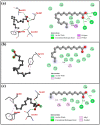Phytochemical Analysis and Binding Interaction of Cotton Seed Cake Derived Compounds with Target Protein of Meloidogyne incognita for Nematicidal Evaluation
- PMID: 36556474
- PMCID: PMC9784384
- DOI: 10.3390/life12122109
Phytochemical Analysis and Binding Interaction of Cotton Seed Cake Derived Compounds with Target Protein of Meloidogyne incognita for Nematicidal Evaluation
Abstract
The root-knot nematode Meloidogyne incognita is one of the most damaging plant-parasitic nematodes and is responsible for significant crop losses worldwide. Rising human health and environmental concerns have led to the withdrawal of commonly used chemical nematicides. There has been a tremendous demand for eco-friendly bio-nematicides with beneficial properties to the nematode hosting plants, which encourages the need for alternative nematode management practices. The current study was undertaken to determine the nematicidal potential of cotton seed cake (CSC) against second-stage juvenile (J2) hatching, J2 mortality, and J2 penetration of M. incognita in tomato plants in vitro. J2s and egg masses of M. incognita were exposed to four concentrations (250, 500, 750, and 1000 mg/L) of CSC extracts. The higher J2 mortality and inhibition of J2 hatching were found at 1000 mg/L, while the least effective result was observed at 250 mg/L of the CSC extract. The CSC extract applied with the concentrations mentioned above also showed inhibition of J2 penetration in tomato roots; 1000 mg/L showed the highest inhibition of penetration, while 250 mg/L displayed the least inhibition. Using gas chromatography-mass spectroscopy, we identified 11 compounds, out of which 9,12-Octadecadienoic acid, Hexadecanoic acid, and Tetradecanoic acid were found as major compounds. Subsequently, in silico molecular docking was conducted to confirm the nematicidal behavior of CSC based on binding interactions of the above three major compounds with the targeted protein acetylcholine esterase (AChE) of M. incognita. The values of binding free energy are -5.3, -4.5, and -4.9 kcal/mol, observed for 9,12-Octadecadienoic acid, n-Hexadecanoic acid, and Tetradecanoic acid, respectively, suggesting that 9,12-Octadecadienoic acid binds with the receptor AChE more efficiently than the other two ligands. This study indicates that CSC has nematicidal potential that can be used to control M. incognita for sustainable agriculture.
Keywords: molecular docking; oil seed cake; phytochemical analysis; plant-parasitic nematodes; sustainable management.
Conflict of interest statement
The authors declare no conflict of interest. The funders had no role in the design of the study; in the collection, analyses, or interpretation of data; in the writing of the manuscript; or in the decision to publish the results.
Figures





Similar articles
-
Croton bonplandianus leaves extract to mitigate the hazardous effect of Meloidogyne incognita: GC-MS and molecular docking analysis of nematicidal compounds.RSC Adv. 2025 Jun 13;15(25):20200-20210. doi: 10.1039/d5ra00931f. eCollection 2025 Jun 10. RSC Adv. 2025. PMID: 40519688 Free PMC article.
-
Harnessing nature's arsenal: Ochrobactrum bacteria metabolites in the battle against root- knot nematode - Insights from in vitro and molecular docking studies.J Invertebr Pathol. 2024 Jun;204:108114. doi: 10.1016/j.jip.2024.108114. Epub 2024 Apr 16. J Invertebr Pathol. 2024. PMID: 38636720
-
First report of Meloidogyne javanica on Ginger and Turmeric in the United States.J Nematol. 2019;51:1-3. doi: 10.21307/jofnem-2019-006. J Nematol. 2019. PMID: 31088018 Free PMC article.
-
Chemical Composition and Nematicidal Properties of Sixteen Essential Oils-A Review.Plants (Basel). 2021 Jul 4;10(7):1368. doi: 10.3390/plants10071368. Plants (Basel). 2021. PMID: 34371571 Free PMC article. Review.
-
Essential Oils as Nematicides in Plant Protection-A Review.Plants (Basel). 2023 Mar 22;12(6):1418. doi: 10.3390/plants12061418. Plants (Basel). 2023. PMID: 36987106 Free PMC article. Review.
Cited by
-
Agro-Industrial Waste from Pistacia vera: Chemical Profile and Bioactive Properties.Plants (Basel). 2025 May 9;14(10):1420. doi: 10.3390/plants14101420. Plants (Basel). 2025. PMID: 40430983 Free PMC article.
-
Hydroalcoholic Extracts from Pleurotus ostreatus Spent Substrate with Nematocidal Activity against Nacobbus aberrans Phytonematode and the Non-Target Species Panagrellus redivivus.Plants (Basel). 2024 Jun 27;13(13):1777. doi: 10.3390/plants13131777. Plants (Basel). 2024. PMID: 38999617 Free PMC article.
-
Research Advances in the Plant-Nematode Interaction.Life (Basel). 2023 Aug 10;13(8):1722. doi: 10.3390/life13081722. Life (Basel). 2023. PMID: 37629579 Free PMC article.
-
Croton bonplandianus leaves extract to mitigate the hazardous effect of Meloidogyne incognita: GC-MS and molecular docking analysis of nematicidal compounds.RSC Adv. 2025 Jun 13;15(25):20200-20210. doi: 10.1039/d5ra00931f. eCollection 2025 Jun 10. RSC Adv. 2025. PMID: 40519688 Free PMC article.
References
-
- Singh S., Singh B., Singh A.P. Nematodes: A threat to sustainability of agriculture. Procedia Environ. Sci. 2015;29:215–216. doi: 10.1016/j.proenv.2015.07.270. - DOI
-
- Escobar C., Barcala M., Cabrera J., Fenoll C. Overview of root-knot nematodes and giant cells. Adv. Bot. Res. 2015;73:1–32.
Grants and funding
LinkOut - more resources
Full Text Sources

